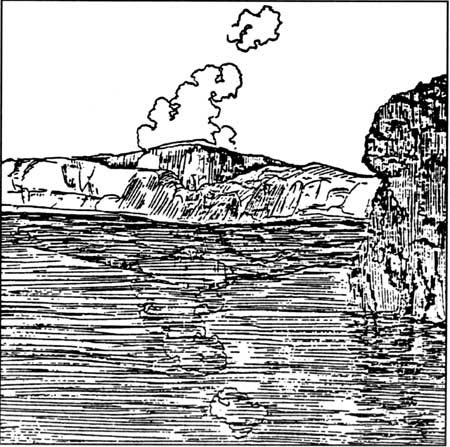|
Volume XXVII - 1996
Llao Speaks
By Tom McDonough
The story of Crater Lake centers on the destruction of a large
volcano, Mount Mazama, and the subsequent accumulation of a deep blue
body of water in its place. The events preceding and immediately
following a final eruption of this volcano occurred at a time when
Native Americans had already established themselves in the region.
Whether the tales about the origin of Crater Lake told to the pioneers a
century ago by the Indians actually date from prehistoric times may
never be known. The stories describe a powerful spirit living beneath
the mountain which the Klamath people called Llao. When angry,
Llao would journey toward the surface and sit atop the mountain
to speak with a voice like thunder. It is difficult to trace the
relationship between these people and the spirit since this began so
long ago. The occurrence of thunder is another matter.
Thunderstorms are more a phenomena of summer than winter in the
region around Crater Lake. Winter thunderstorms are not unknown, but
snowstorms are much more common. That is not to say that thunderstorms
are common in the park during summer. If anything, these weather events
are more of an exception. Summer weather is usually mild during July and
August. Daytime highs are mostly in the mid to upper 70s and night time
lows are in the 40s. A high pressure system aloft, the Pacific High,
dominates our summer climate. The resulting warm and dry surface
conditions at the higher elevations are ideal for camping and
sightseeing from July to September.
Summer thunderstorms arise when moisture is lifted to form the tall
cloud type called cumulonimbus. This happens when an upper level
low pressure system located offshore of northern California directs
moisture inland and across the Cascade Range. Thunderstorms can also
occur in the area when moisture is drawn in a northerly direction along
the western edge of high pressure centered over Nevada or Utah.
What happens inside the growing cloud to separate static charges,
with a thunderstorm being the eventual result, is thus far imperfectly
known. What we do know is that charges separate with the cloud's base
becoming negatively charged and the ground or water body below being
positively charged. Since the air acts to insulate the charged cloud
droplets, a potential of 3,000 volts per meter can develop prior to a
lightning strike. The lightning bolt is electrical current connecting
the ground or lake surface with the cloud base in order to neutralize
the charge separation (lightning can also connect clouds to one another
and isolated cells within a cloud). The flash of lightning, which lasts
for less than a second, heats the nearby air to over 10,000 degrees
Fahrenheit. The rapidly expanding air travels at supersonic speeds and
produces a shock wave we hear as thunder. This sound is louder the
closer an observer is to the discharge. Thunder is rarely heard if the
observer is more than 12 miles away, even when the lightning is clearly
visible. To estimate distance from a discharge, some people count
between seeing a flash and hearing thunder. If five seconds elapsed
between the lightning and subsequent thunder, then the discharge
occurred about one mile away from the observer.
Lightning is attracted to high spots around the rim of Crater Lake
since the distance between cloud base and surface is less. Since many
park trails ascend points such as Garfield Peak, Mount Scott, and the
Watchman, hikers should keep a watchful eye to the sky on days when
cumulus clouds fill the air. As a safety measure, weather forecasts are
posted at the two visitor centers each morning. In addition to trees and
rock outcrops around the rim that attract lightning, Crater Lake can be
struck by discharges from the clouds. Water conducts electrical charges
easily, and with a surface area of roughly 25 square miles, the lake
presents quite a target.
Lightning strikes over the park can be an awesome display of
nature's power. The associated thunder can fill the old glacial valleys
of Mount Mazama and put fear into animals as well as humans. During a
brief episode of thunder and lightning, as the wind bends the trees and
marble-size hail pounds the ground, the ancient story of Llao
comes to mind, reminding some of us that great power is nearby and can
shake the earth.
Tom McDonough teaches science at Chemeketa Community College
in Salem, Oregon, and has been a seasonal naturalist at Crater Lake
since 1969.

Karl J. Belser in Ernest G. Moll, Blue Interval,
Portland: Metropolitan Press, 1935, p. 26.
| 
